
- Shandong Loyal Industrial Co.,Ltd.
- Macaroni Production Machine Instant Noodle Machine Biscuit Making Machine
Home> Company News> Fried Instant Noodle Processing Line

Fried Instant Noodle Processing Line
2023-07-17 12:16:43The Loyal series fried instant noodle processing line has the advantages of advanced technology, high capacity, low consumption and high degree of automation. Instant Noodle Making Machine adopts touch screen delivery presetting, photoelectric tracking, frequency control and PLC program controi from ripening process to cooling process has realizes stand-alone fine tuning,whole line linkage,synchronous acceleration and deceleration program control.The instant noodles production line features automatic control of frying temperature, safe and reliable operation, convenient maintenance, low oil content of noodle cake and high rate of qualified product. The instant noodles machine surfaces food touched adopt stainless steel and food grade materials, accord with requirement of the food hygien-ic standard. The produced noodles have the characteristics of deliciousness, crispness, smoothness and chewiness.
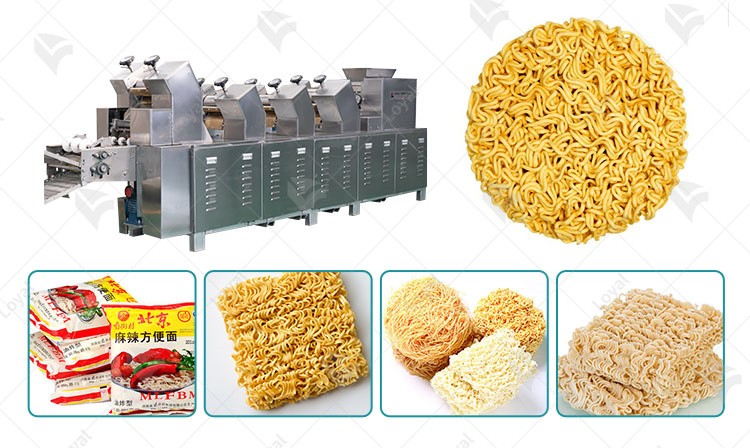
The Flow Chart Of Instant Noodle Processing Line
- Flour Conveyor --- 2. Alkali Liquid Weighing Tank --- 3. biaxial mixing Machine --- 4. Compound Rolling Machine --- 5. Continuous Rolling Machine --- 6. Steaming Machine --- 7. Cutting,Folding&Dividing Machine --- 8. Distributing Machine --- 9. Frying Machine --- 10. Cooling Machine --- 11. Finished Product Conveyor --- 12. Packing Machine
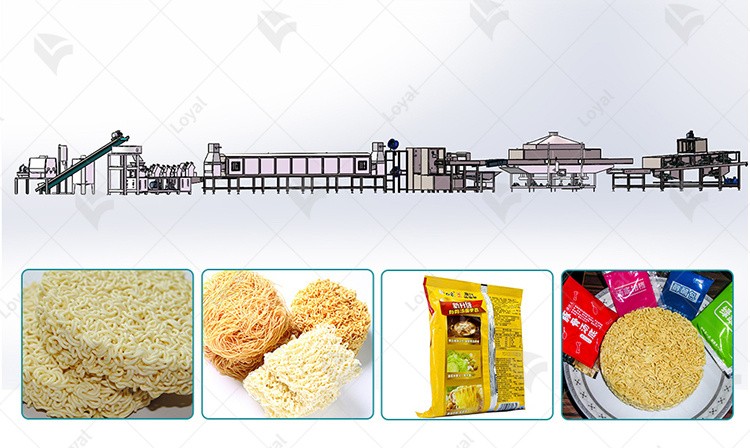
The Function Of Instant Noodle Processing Line
The instant noodle processing line is a series of machinery and equipment used to produce instant noodles in a continuous and efficient manner.
The main functions of each component in the instant noodle processing line are as follows:
- Flour Mixing: This process involves mixing flour, water, and other ingredients to form the noodle dough. The mixing equipment ensures proper hydration and uniform distribution of ingredients.
- Dough Sheeting: The dough sheeter rolls out the dough into thin sheets and cuts them into desired shapes and sizes. It helps in forming the initial shape of the noodles.
- Steaming: The noodle sheets are steamed to partially cook them and enhance their texture. Steaming machines use high-temperature steam to quickly and evenly cook the noodles.
- Cutting: After steaming, the partially cooked noodle sheets are cut into strands of the desired length. The cutting equipment typically uses blades or knives to achieve the desired shape and size.
- Drying: The cut noodles are then dried to remove moisture and extend their shelf life. Drying can be done through various methods, such as air drying, frying, or a combination of both.
- Frying: Some instant noodles are fried to give them a crispy texture and enhanced flavor. The frying process also helps in reducing moisture content and prolonging shelf life.
- Flavoring and Packaging: Once the noodles are dried or fried, they are flavored with seasonings, sauces, and spices to enhance their taste. Packaging machines are used to pack the instant noodles into individual portions, such as bags, cups, or bowls, ready for distribution and consumption.
- Quality Control: Throughout the processing line, quality control measures, such as inspection of raw materials, monitoring of processing parameters, and regular testing of finished products, are implemented to ensure the product's quality and safety.
The instant noodle processing line is designed to streamline the production process, increase production efficiency, and produce consistent quality instant noodles.
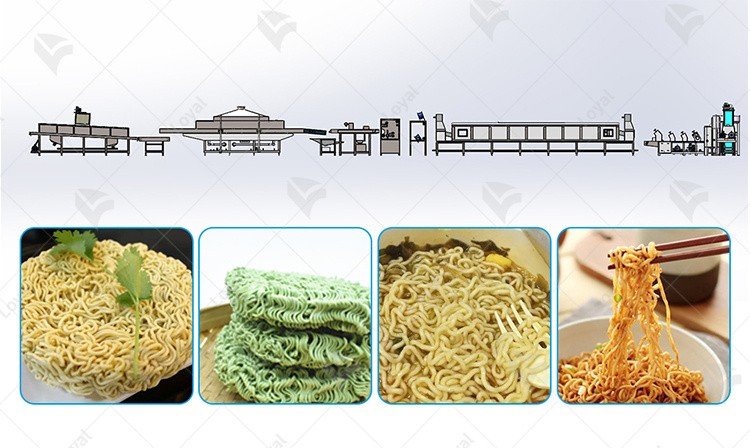
Instant Noodles Production Line Parameters
|
Device Mode |
Yield |
Steam Consumption Kg/Hour |
Size Of Fnctor:Model No.
|
0pening Width |
Installed Capacity
|
Operator (2 Without Packaging People)
|
|
LYN-II 3Y |
30.000pieces/8h |
1000-1200
|
60×6×4.5 |
216~260 |
42 |
4 |
|
LYN-II 6Y |
60.000 pieces/8h |
1200-1400 |
76×8×4.5 |
300~330 |
56 |
4 |
|
LYN-II 8Y |
80.000 pieces/8h |
1300-1500 |
76×8×4.5 |
420~450 |
68 |
6 |
|
LYN-II 10Y |
100,000 pieces/8h |
1400-1600 |
95×8×5.0 |
420~450 |
80 |
6 |
|
LYN-II 12Y |
120,000 pieces/8h |
1800-2000 |
95×8×5.0 |
510~550 |
83 |
6 |
|
LYN-II 16Y |
160,000 pieces/8h |
2000-2400 |
110×10×5.5 |
630~650 |
106 |
7 |
|
LYN-II 18Y |
180,000 pieces/8h |
2400-2600 |
110×10×5.5 |
720~730 |
114 |
7 |
|
LYN-II 20Y |
200,000 pieces/8h |
2600-2800 |
120×12×5.5 |
765~800 |
125 |
8 |
|
LYN-I1 25Y |
250,000 pieces/8h |
3000-3200 |
120×12×5.5 |
870~900 |
190 |
8 |
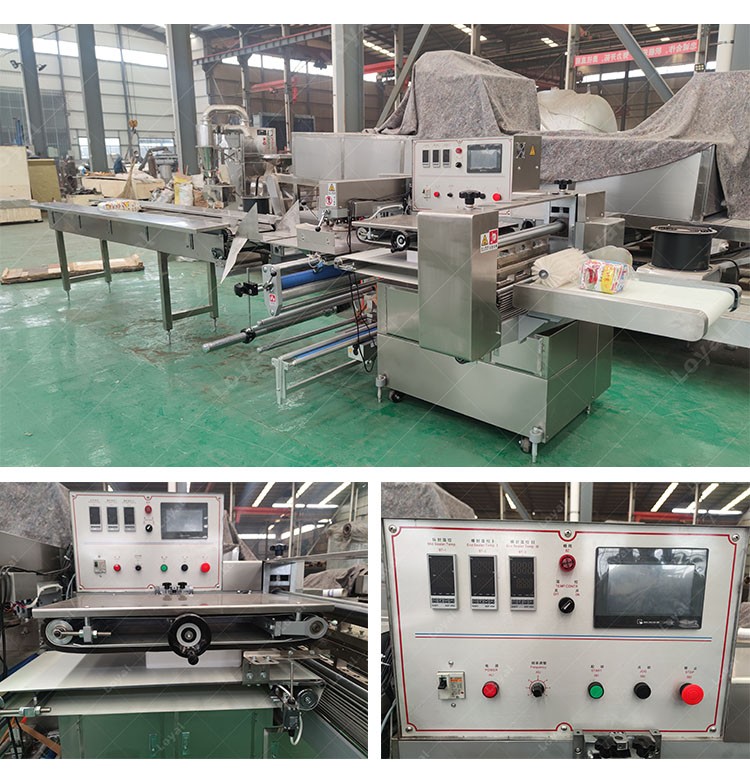
The Features Of Fried Instant Noodles Production Line
|
Automated Operation |
The production line is designed for continuous and automated operation, reducing the need for manual labor and increasing efficiency. It can handle large-scale production and minimize human error. |
|
Customizable Configurations |
The production line can be customized to meet specific production requirements, such as different noodle shapes, sizes, and flavors. This flexibility allows manufacturers to cater to various market demands. |
|
Plc Control System |
A programmable logic controller (PLC) is typically used to control and monitor the entire production process. The control system ensures accurate and consistent control of various parameters, such as mixing time, frying temperature, and packaging speed. |
|
High-Speed Processing |
The production line is designed to operate at high speeds, ensuring a large volume of noodles can be produced within a shorter period. Efficient conveyors and processing equipment enable fast and continuous production. |
|
Energy Efficiency |
Modern production lines are designed to optimize energy consumption, minimizing waste and reducing production costs. Energy-efficient motors, heat recovery systems, and insulation materials help to achieve this. |
|
Hygienic Design |
The production line is designed with hygienic considerations, including easy-to-clean surfaces, smooth transitions, and food-grade materials. This ensures that the noodles are produced in a clean and sanitary environment, meeting food safety standards. |
|
Quality Control Systems |
Integrated quality control systems are implemented throughout the production process to monitor and maintain product quality. This may include sensors, monitors, and automatic rejection systems to detect and remove defective products. |
|
Easy Maintenance And Troubleshooting |
The production line is designed for easy maintenance and troubleshooting. Accessible components, clear labeling, and user-friendly interfaces make it easier for operators to maintain and repair the equipment. |
|
Safety Features |
Safety measures, such as emergency stop buttons, safety guards, and alarm systems, are incorporated into the production line to protect operators and maintain a safe working environment. |
|
Data Monitoring And Reporting |
Some advanced production lines may have built-in data monitoring and reporting capabilities. This allows operators to track and analyze production data, identify areas for improvement, and optimize production processes. |
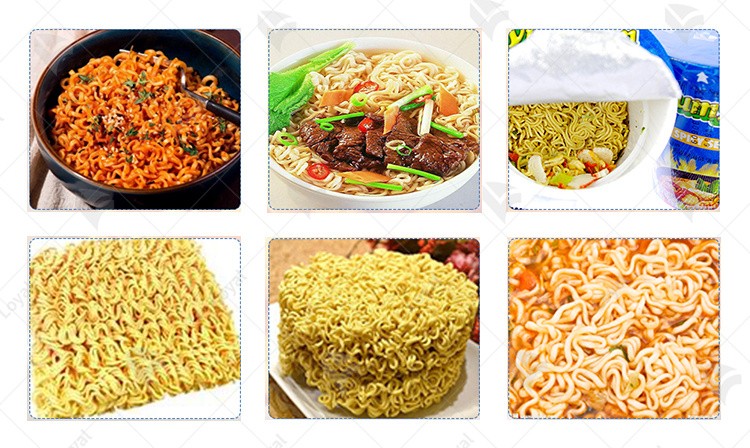
 Commercial Japanese Panko Bread Crumb Grinder Machine
Commercial Japanese Panko Bread Crumb Grinder Machine Japanese Bread Crumbs Processing Line
Japanese Bread Crumbs Processing Line Automatic Cookies Making Machines
Automatic Cookies Making Machines Fully Automatic Biscuit Making Machines
Fully Automatic Biscuit Making Machines